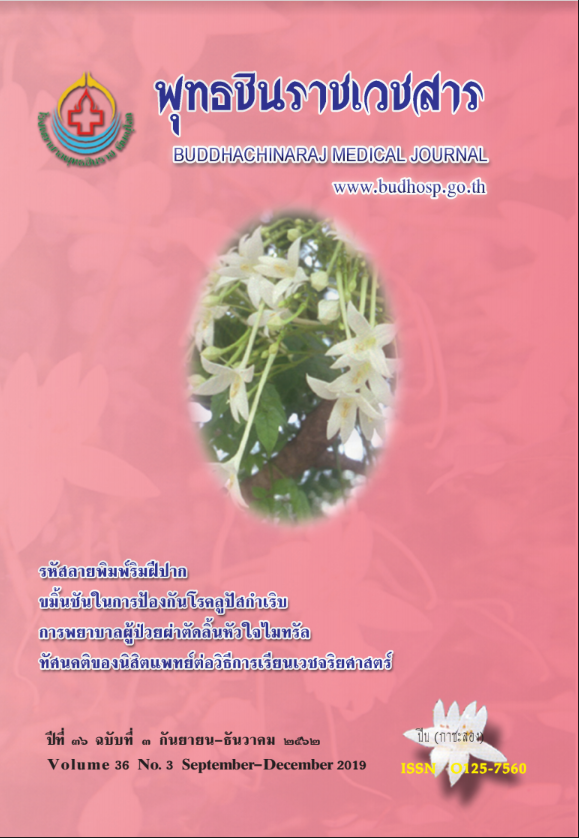ทัศนคติของนิสิตแพทย์ระดับชั้นคลินิกต่อวิธีการเรียนเวชจริยศาสตร์ ด้านสูติศาสตร์และนรีเวชวิทยา
ทัศนคติของนิสิตแพทย์ต่อวิธีการเรียนเวชจริยศาสตร์
คำสำคัญ:
จริยธรรมทางการแพทย์, กรณีศึกษา, ทัศนคติ, คุณสมบัติของอาจารย์แพทย์บทคัดย่อ
การสอนเวชจริยศาสตร์เป็นหัวข้อที่ท้าทายในหลักสูตรแพทยศาสตรบัณฑิต เป็นการยากที่จะสอนให้นิสิตเกิดความมั่นใจและสามารถนำไปประยุกต์ความรู้ใช้ในสถานการณ์จริงได้ การสำรวจด้วยแบบสอบถามนี้มีวัตถุประสงค์เพื่อประเมินทัศนคติของนิสิตแพทย์ชั้นปีที่ 5 ต่อวิธีการสอนเวชจริยศาสตร์ด้านสูติศาสตร์และนรีเวชวิทยา รวมทั้งคุณสมบัติที่สำคัญของอาจารย์ที่ควรเป็นผู้สอนจริยธรรมทางการแพทย์ขณะปฏิบัติงานที่ภาควิชาสูติศาสตร์-นรีเวชวิทยา โรงพยาบาลมหาวิทยาลัยนเรศวร ในหัวข้อความผิดพลาดทางการแพทย์และการเปิดเผยความผิดพลาดสอนโดยใช้กรณีศึกษาและอภิปรายกลุ่มย่อย ผลการศึกษาพบว่านิสิตแพทย์ร้อยละ 98.5 เห็นด้วยกับการเรียนแบบอภิปรายกลุ่มย่อยว่ามีผลต่อกระบวนการเรียนรู้มากกว่าการเรียนแบบบรรยาย ส่วนคุณสมบัติที่สำคัญของอาจารย์ที่ควรเป็นผู้สอนจริยธรรมทางการแพทย์คือเป็นผู้มีประสบการณ์ในการทำงานและการสอน เป็นผู้ฟังที่ดีและเป็นแบบอย่างที่ดีสำหรับนิสิตแพทย์ สรุปได้ว่าการใช้กรณีศึกษาและคำถามนำสามารถกระตุ้นความคิดอย่างมีเหตุผลของนิสิตแพทย์ได้ คุณสมบัติที่เหมาะสมของอาจารย์ผู้สอนมีผลด้านบวกอย่างมากต่อทัศนคติของนิสิตและบรรยากาศในการเรียนรู้
เอกสารอ้างอิง
2. Calman KC, Downie RS. Practical problems in the teaching of ethics to medical students. J Med Ethics 1987;13(3):153-6.
3. Eckles RE, Meslin EM, Gaffney M, Helft PR. Medical ethics education: where are we? Where should we be going? A review. Acad Med 2005;80(12):1143-52.
4. Cummings CL. Teaching and assessing ethics in the newborn ICU. Semin Perinatol 2016;40(4):261-9.
5. Dickinson BL, Lackey W, Sheakley M, Miller L, Jevert S, Shattuck B. Involvinga real patient in the design and implementation of case-based learning to engage learners. Adv Physiol Educ 2018;42(1):118-22.
6. Bell K, Boshuizen HP, Scherpbier A, Dornan T. When only the real thing will do: junior medical students' learning from real patients. Med Educ 2009;43(11):1036-43.
7. Self DJ, Wolinsky FD, Baldwin DC Jr. The effect of teaching medical ethics onmedical students' moral reasoning. Acad Med 1989;64(12):755-9.
8. Lawson AD. What is medical ehtics? Trends Anaesth Crit Care 2011;1(1):3-6.
9. Klingensmith ME. Teaching ethics in surgical training programs using a case-based format. J Surg Educ 2008;65(2):126-8.
10. Byrne J, Straub H, DiGiovanni L, Chor J. Evaluation of ethics education in obstetrics and gynecology residency programs. Am J Obstet Gynecol 2015;212(3):397.e1-8.
11. Khatiban M, Falahan SN, Amini R, Farahanchi A, Soltanian A. Lecture-based versus problem-based learning in ethics education among nursing students. Nurs Ethics 2019;26(6):1753-64.
12. Rees C, Sheard C, McPherson A. Medical students' views and experiences of methods of teaching and learning communication skills. Patient Educ Couns 2004;54(1):119-21
13. Fawzi MM. Medical ethics educational improvement, is it needed or not?! Survey for the assessment of the needed form, methods and topics of medical ethics teaching course amongst the final years medical students, Faculty of Medicine, Ain Shams University (ASU), Cairo, Egypt 2010. J Forensic Leg Med 2011;18(5):204-7.






